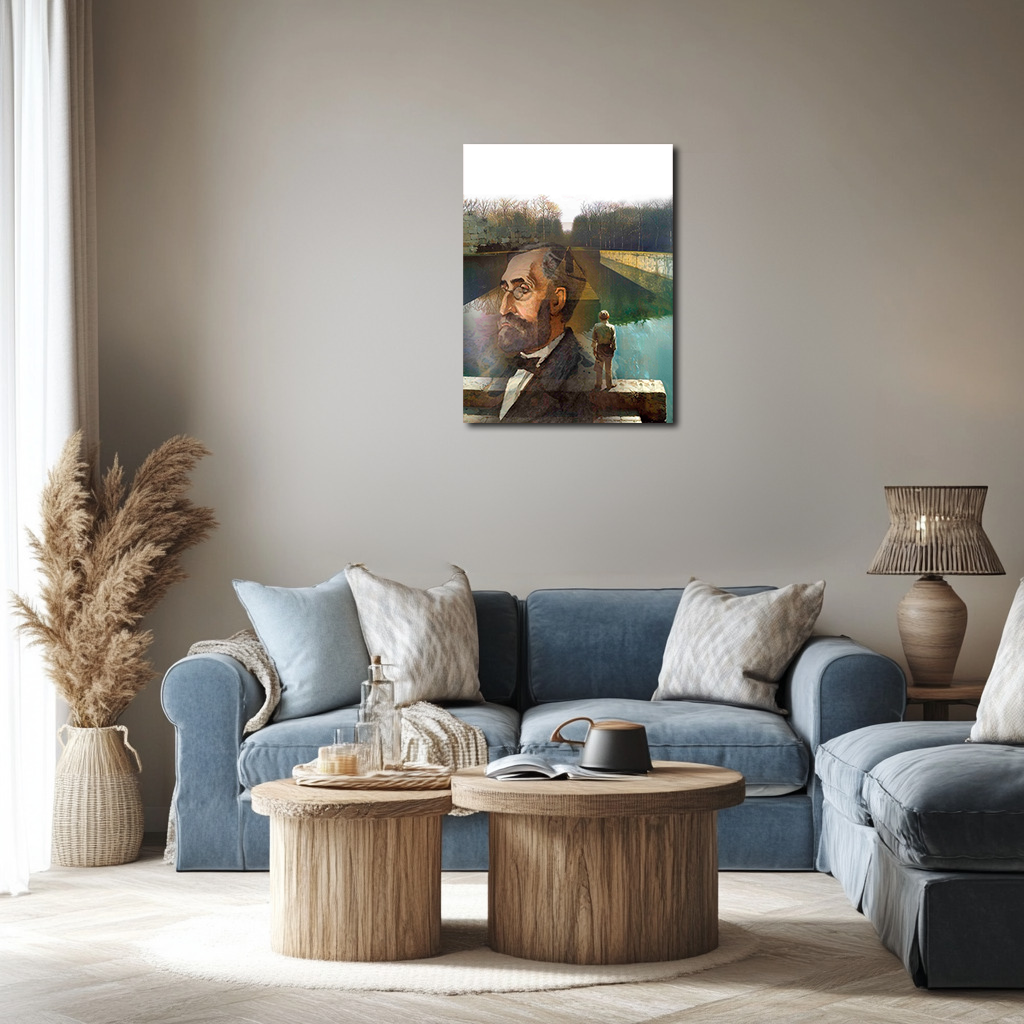Echoes of Reflection: Adolphe Monet in the Geometry of Distance
Echoes of Reflection: Adolphe Monet in the Geometry of Distance transforms Claude Monet’s 1867 portrait of his father into a conceptual meditation on memory, legacy, and unspoken dialogue. A boy stands beside a quiet canal, watching the ghost of a father emerge from water and time. Through stillness, symmetry, and layered presence, the piece explores how history lives in silence and how the past waits not behind us, but ahead.
Please see Below for Details…
Hotline Order:
Mon - Fri: 07AM - 06PM
404-872-4663
Claude Monet’s Portrait of a Man (Adolphe Monet) , painted around 1867, remains one of the few direct records of the artist’s father—a figure more grounded in the formalities of tradition than the radical light his son would pursue. The portrait itself is stoic, introspective, shadowed with reserve and authority. It reflects a father’s presence not only through likeness, but through weight—a man of a different vision, whose silent expectations hovered over a son’s unfolding freedom. In this conceptual reinterpretation, titled Echoes of Reflection: Adolphe Monet in the Geometry of Distance , the portrait transcends biography and enters a realm of symbolic space, memory, and confrontation. What emerges is not just a man rendered in brushwork, but a presence carried in water, mirrored in stone, and walked toward across the narrowing path of generational silence.
The setting is minimal but immense—a canal flanked by ancient trees, their winter limbs bare and reaching. The water is still, unnaturally glass-like, a reflective surface that does not ripple but holds the sky in hushed equilibrium. A central walkway extends forward in perfect symmetry, tapering into vanishing point, drawing the eye toward an unseen horizon where form meets absence. Along this path, a solitary figure walks—cloaked, distant, and diminishing. He is neither fleeing nor arriving. He is returning. Or perhaps he is the echo of a step never taken.
Superimposed over this quiet geometry is the face of Adolphe Monet, rendered from the original painting. His expression is thoughtful, tight-lipped, and intelligent—eyes behind glasses staring not at the viewer, but to the side, as though in contemplation or hesitation. Yet here, his form does not rest on canvas. It rises like fog from the water, half-remembered, emerging from the liquid mirror and fading into the air. His presence does not interrupt the scene—it inhabits it, gently overwhelming it with presence. He is no longer just a subject of portraiture. He has become the embodiment of memory’s weight.
To the right of the image, a boy stands at the edge of the canal. Small in stature, clothed in casual earth tones, he gazes across the water not at the viewer, but toward the vision of the father suspended in reflection. His body language is quiet, but alert—hands by his sides, not clenched, not open. He does not move. He observes. This boy could be Claude. Or he could be any son standing in the silent architecture of legacy.
The spatial dynamic of the piece is crucial. The canal forms a corridor of symmetry, suggesting both ritual and separation. The walkway through the center creates a bridge between past and present, but it also functions as a question—who crosses, and who remains still. The space is clean, geometric, almost sacred. Like a temple of unspoken thought. A place built not of brick or wood, but of expectation and restraint.
Color is used with restraint and intention. The trees, faded into near monochrome, hold the memory of life now suspended. The stone and water are rendered in softened greys and pale greens, reflecting a world not drained of emotion, but filtered through memory. Adolphe’s visage is warmer—brown, ochre, and subtle reds echo the tones of flesh, but they blend back into the water, never fully distinct. The boy stands in contrast—small, real, untouched by the painter’s brush but placed in his shadow.
Light moves through the piece like a breath. It falls from above with a gentle white glow, diffused and directionless, softening all edges. There are no harsh contrasts, no drama. Only atmosphere. Stillness becomes the narrative. The silence between figures becomes the dialogue. Every element breathes with a tension that feels both ancient and unresolved.
As the artist, I envisioned this reinterpretation not as a tribute, but as a reckoning. Portrait of a Man was never just about Adolphe Monet’s face—it was about presence, position, and the kind of authority that resides in formality. In Echoes of Reflection , that authority is expanded into myth. The father becomes landscape. The portrait becomes horizon. The canal becomes time. The boy does not resist it—he simply sees it. The image asks what it means to carry the weight of someone who stands behind us, unseen, casting their gaze long after their step has faded.
This is not a confrontation. It is a meditation. On legacy. On silence. On how presence lingers not just in faces, but in the spaces we move through, and in the reflections that appear only when we choose to stop and look.
Add your review
Your email address will not be published. Required fields are marked *
Please login to write review!
Looks like there are no reviews yet.








